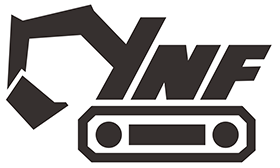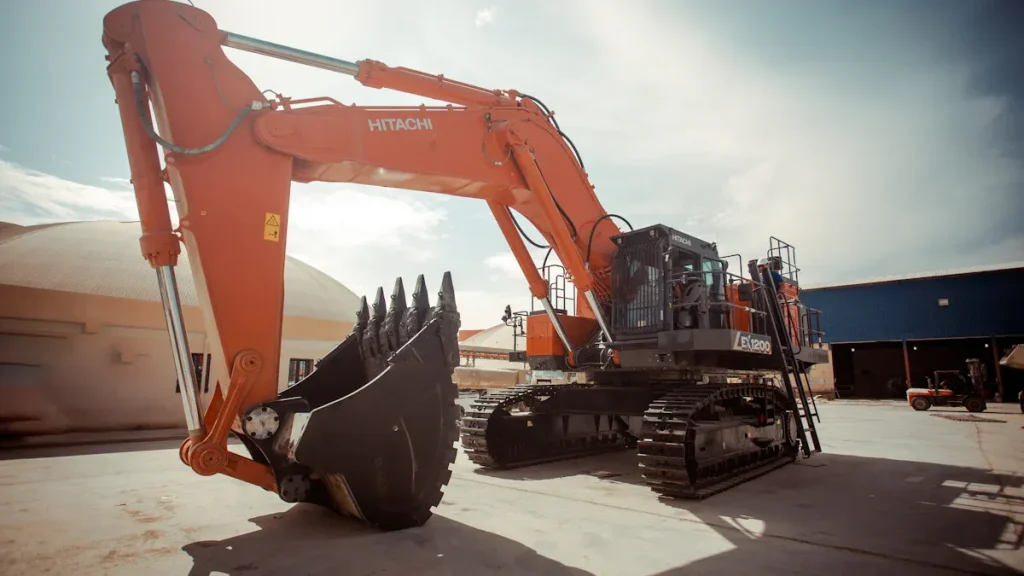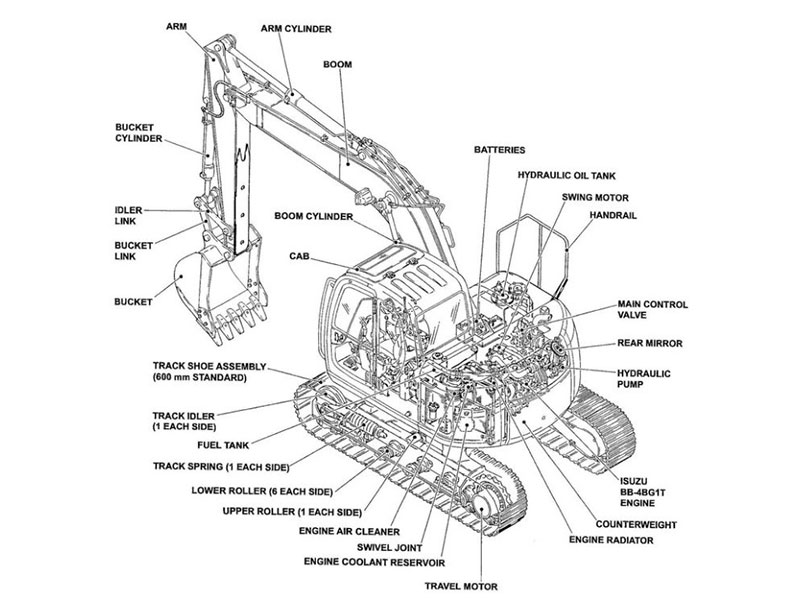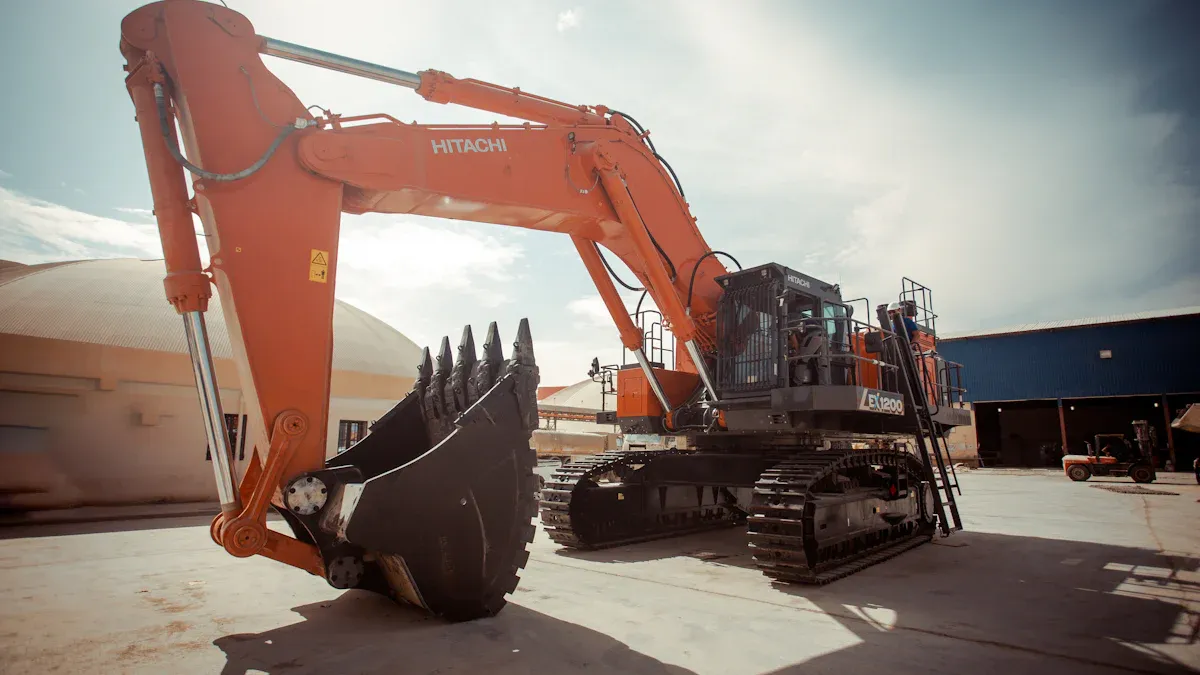
Understanding the important parts of the Hitachi 200 excavator helps it work well and stay in good shape. The main parts are the engine, hydraulic system, undercarriage, electrical systems, and buckets or attachments. Each part is important for the machine to work, from giving power to making accurate movements.
Knowing these hitachi 200 excavator parts helps you spot problems early and keep it running its best. Checking it often stops expensive fixes and makes it last longer.
Key Takeaways
Knowing the key parts of the Hitachi 200 excavator, like the engine and hydraulic system, helps it work well and last longer.
Taking care of it, like checking oil and hydraulic lines, stops big problems and makes the excavator last longer.
The undercarriage keeps the machine steady; fixing tracks and rollers helps it move safely on different grounds.
Electrical parts, like sensors and controls, make it safer and better; checking them often avoids delays.
Picking the right buckets and tools for each job makes work faster and keeps the machine in good shape.
Engine and Powertrain in Hitachi 200 Excavator
Engine Function and Importance
The engine is like the heart of the Hitachi Zaxis 200. It gives the power needed to make the excavator work well. A good engine helps with digging, lifting, and moving smoothly. Modern engines in the Hitachi Zaxis 200 follow strict environmental rules. They lower harmful gases while still working strongly.
Better engines have brought these changes:
3-5% more efficiency with each EPA emissions rule update.
11-15% better fuel use since 1996.
96% less nitrogen oxides (NOx) and diesel particles per gallon of fuel.
These changes make the machine work better and help the environment.
Powertrain’s Role in Performance
The powertrain works with the engine to send energy to moving parts. It helps the Hitachi Zaxis 200 work accurately and dependably. The powertrain has parts like the transmission, axles, and driveshafts. These parts work together to send power where it’s needed.
A good powertrain saves energy and uses less fuel. For example:
Feature | What It Does |
|---|---|
Energy Regeneration | Makes energy reuse better by 23%. |
Energy Savings | Saves up to 61.64% energy. |
Regeneration Efficiency | Reuses up to 73% energy when lowering cylinders. |
These features help the Hitachi Zaxis 200 do tough jobs without wasting energy.
Maintenance Tips for Engine and Powertrain
Taking care of the engine and powertrain is very important. Ignoring them can cause big problems and cost a lot to fix. Here are some simple tips to keep them in good shape:
Check the Engine Oil: Change the oil on time to avoid damage.
Monitor Fuel Quality: Use clean fuel to stop injector clogs.
Inspect the Powertrain: Fix strange noises or vibrations quickly.
Clean Air Filters: Replace dirty filters for better airflow.
Follow the Manufacturer’s Guidelines: Stick to Hitachi’s maintenance plan for the Zaxis 200.
Tip: Regular checks can catch problems early and save money later.
By doing these steps, your Hitachi Zaxis 200 will last longer and work its best.
Hydraulic System of Hitachi Zaxis 200 Excavator
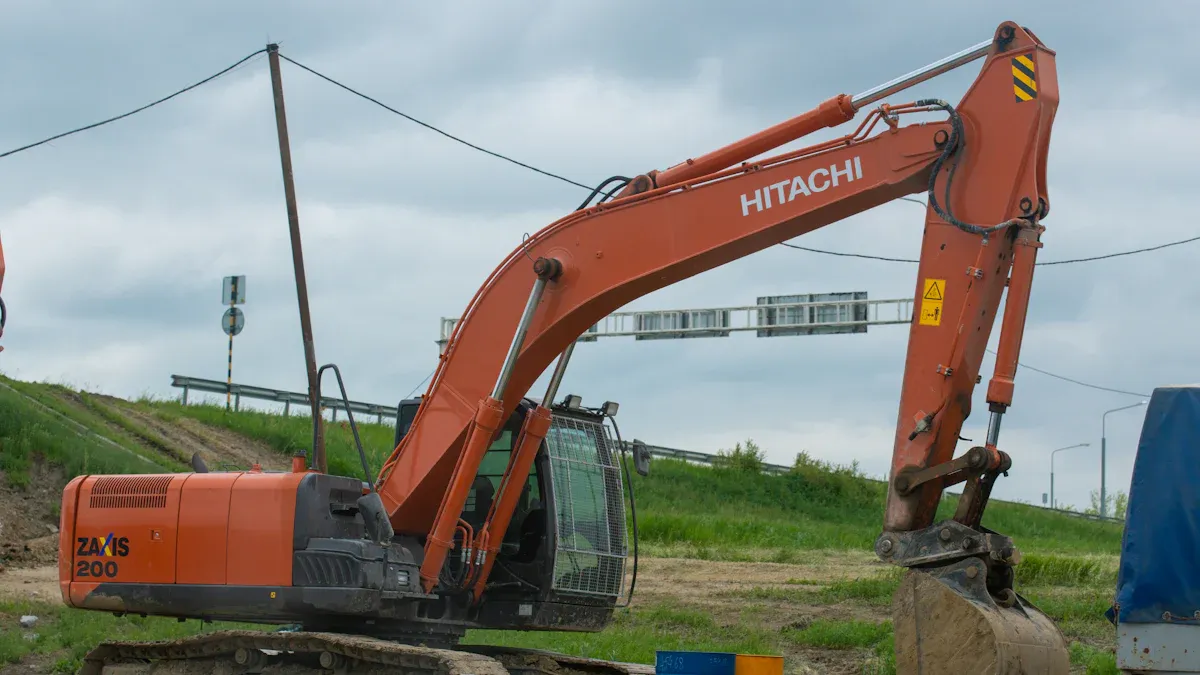
Key Hydraulic Components
The hydraulic system in the Hitachi Zaxis 200 is very important. It has several main parts that work together to provide power and control. These parts include:
Hydraulic Pump: Creates pressure to move fluid through the system.
Hydraulic Cylinders: Turn hydraulic energy into force for movement.
Control Valves: Manage where the hydraulic fluid flows.
Hydraulic Lines: Carry fluid between parts for smooth operation.
Each part helps the system work well. When these parts are in good shape, the excavator can dig and lift easily.
Tip: Learn about these parts to spot problems early and keep the system working well.
How Hydraulics Enable Movement
Hydraulics make the Hitachi Zaxis 200 strong and flexible. The system uses pressurized fluid to create force, which moves different parts. Here’s how it works:
The hydraulic pump pushes fluid under pressure.
The fluid moves through control valves to the cylinders.
The cylinders move in or out, creating motion.
This process helps the excavator lift heavy things, turn its arm, and dig hard ground. Hydraulics allow smooth and accurate movements, making it great for construction jobs.
Note: Keeping the right hydraulic pressure is important. Low pressure can slow down work and cause problems.
Maintenance Practices for Hydraulic Systems
Taking care of the hydraulic system keeps your Hitachi Zaxis 200 working well. Regular maintenance stops breakdowns and saves money on repairs. Follow these steps to keep it in good condition:
Inspect Hydraulic Lines: Look for leaks or damage. Replace bad lines quickly.
Monitor Fluid Levels: Keep fluid at the right level to avoid problems.
Change Hydraulic Filters: Swap out old filters to stop dirt from clogging the system.
Check for Pressure Issues: Test pressure to make sure it’s at the right level.
Clean Components: Remove dirt from parts to prevent damage.
By doing these steps, your excavator will last longer and work better.
Alert: Skipping hydraulic maintenance can lower performance and cost a lot to fix.
Undercarriage Components in Hitachi 200 Excavator
Tracks, Rollers, and Shoes
The undercarriage of the Hitachi 200 excavator has tracks, rollers, and shoes. These parts are key for movement and balance. Tracks spread the machine’s weight evenly and give traction. Rollers and idlers keep the tracks in place and moving smoothly. Shoes, attached to tracks, help grip and last longer on different surfaces.
These parts work together to handle tough jobs. Tracks let the excavator move on soft or uneven ground without sinking. Rollers and idlers keep the tracks tight and prevent slipping off. Shoes improve grip on surfaces like mud or gravel, making work easier.
Why Undercarriage Stability Matters
The undercarriage keeps the excavator steady while working. It holds the machine’s weight and lowers its center of gravity to stop tipping. Good undercarriage parts also help the excavator move safely on rough ground.
Here’s how each part helps with stability:
Component | How It Helps Stability |
|---|---|
Tracks | Spread weight, improve grip, and last longer. |
Rollers & Idlers | Keep tracks tight, smooth, and reduce repairs. |
Sprockets | Move tracks, share weight, and last longer. |
Frame | Gives support, lowers gravity, and adds balance. |
Monitoring Systems | Show real-time data to catch problems early. |
Taking care of these parts keeps the excavator steady and working well.
Tips for Maintenance and Inspection
Looking after the undercarriage stops big repairs and delays. Check tracks for damage or wear. Look at rollers for cracks or leaks. Make sure sprockets and shoe bolts are tight. Lubricate pins and joints to avoid friction and wear.
Here are more tips to keep it in good shape:
Inspect often: Check for loose bolts or worn-out parts.
Adjust track tension: Tighten tracks to avoid fast wear and improve use.
Avoid speeding: High speeds or too much reversing wear out tracks faster.
Limit slope time: Spend less time on slopes to reduce stress on parts.
Use telematics: Watch data to find problems early and fix them.
Following these steps will make the undercarriage last longer and work better on any job site.
Electrical Systems in Hitachi Zaxis 200 Excavator
Overview of Electrical Components
The electrical system helps the Hitachi Zaxis 200 work smoothly. It has important parts that power and control the machine. These include:
Battery: Starts the engine and powers electrical systems.
Alternator: Charges the battery and powers parts while working.
Wiring Harness: Connects electrical parts for smooth power flow.
Control Panel: Lets you check and adjust the excavator’s settings.
These parts keep the excavator running well. Taking care of the electrical system avoids problems and saves time on job sites.
Role of Sensors and Controls
Sensors and controls make the Hitachi Zaxis 200 safer and more efficient. They check how the machine is working and find problems early. Important sensors include:
Proximity Sensors: Spot nearby objects to stop accidents.
Pressure Sensors: Check hydraulic pressure to avoid damage.
Temperature Sensors: Keep parts safe by watching heat levels.
Sensors are key for safety. For example:
Safety sensors find dangers and stop accidents.
Worker-worn sensors warn about power line risks.
Good sensors help the excavator work safely, even in tough conditions.
Troubleshooting Electrical Issues
Electrical problems can slow down your excavator. Fixing them fast is important. Common issues and solutions include:
Dead Battery: Check the battery and replace it if needed.
Faulty Wiring: Look for broken wires or loose connections. Fix them quickly.
Sensor Problems: Test sensors often and replace bad ones.
Control Panel Errors: Reset the system or check the manual for help.
Tip: Regular checks stop most electrical problems. Keep spare parts ready to avoid delays.
Knowing how the electrical system works and fixing issues early keeps your Hitachi Zaxis 200 safe and reliable.
Buckets and Attachments for Hitachi 200 Excavator
Types of Buckets and Attachments
Buckets and attachments make your excavator more useful for different jobs. The Hitachi 200 has many options to fit various tasks. Common types include:
Standard Buckets: Best for basic digging and loading work.
Rock Buckets: Built to handle hard materials like rocks and gravel.
Trenching Buckets: Great for digging narrow and precise trenches.
Thumb Attachments: Helps grab and lift odd-shaped objects.
Hydraulic Breakers: Breaks concrete or tough surfaces easily.
The need for these tools is growing fast. For example:
In 2023, the bucket thumbs market was worth USD 1.2 billion. By 2032, it may reach USD 2.1 billion due to better technology.
The excavator attachments market, valued at USD 6.96 billion in 2023, could grow to USD 10.04 billion by 2030. The Asia Pacific region leads with a 33.4% share.
These numbers show how important attachments are in construction and mining.
Functions of Front-End Attachments
Front-end attachments make the Hitachi 200 more capable. Buckets are used for digging, scooping, and loading materials. Thumb attachments help lift odd-shaped items like logs or debris. Hydraulic breakers speed up demolition tasks.
Each tool is made for specific jobs. Trenching buckets dig narrow trenches accurately. Rock buckets handle heavy, rough materials without damage. Picking the right tool makes work faster and protects your machine from wear.
Maintenance and Replacement Guidelines
Taking care of buckets and attachments keeps them working longer. Inspect them often for cracks, worn edges, or loose bolts. Replace broken parts quickly to avoid bigger problems.
Keep records of inspections and repairs. This helps you notice wear patterns and fix repeated issues. A good maintenance plan saves money and extends the life of your tools.
Clean attachments after each use to stop material buildup. Lubricate moving parts to reduce friction. Follow the manufacturer’s advice for when to maintain or replace parts. Regular care keeps your attachments in great shape and prevents delays.
Maintenance Schedule for Hitachi 200 Excavator Parts
Recommended Maintenance Intervals
Keeping a regular maintenance schedule helps your excavator work well. Hitachi suggests specific times to check and service parts:
Daily: Check fluids, clean the machine, and inspect tracks.
Every 250 hours: Change engine oil and replace filters.
Every 500 hours: Look at hydraulic lines and swap hydraulic filters.
Every 1,000 hours: Check undercarriage wear and tighten bolts.
Annually: Inspect all systems, including electrical and safety features.
Following these times stops breakdowns and makes the machine last longer. Always check the operator’s manual for exact schedules for your Hitachi 200.
Preventative Maintenance Tips
Preventative care stops expensive repairs. Simple steps can make a big difference:
Lubricate Moving Parts: Add grease often to reduce wear and friction.
Monitor Fluid Quality: Use clean oils to avoid contamination problems.
Inspect Filters: Replace dirty filters to keep airflow and fluids moving.
Tighten Loose Bolts: Secure bolts to avoid damage to the structure.
Studies show that using data to plan maintenance saves money and extends machine life. By combining preventative and repair strategies, your excavator stays in great shape for years.
Tip: Write down maintenance tasks in a logbook to track problems.
Importance of Regular Inspections
Regular checks help find problems early. Inspecting key parts keeps the machine safe and reliable. The table below shows why checking parts is important:
Component | Why It’s Important |
|---|---|
Look for leaks and check fluid levels to avoid damage. | |
Electrical system | Make sure alarms and lights work for safety. |
Undercarriage components | Check tracks and rollers for damage to keep the machine moving. |
Tires | Inspect for wear or misalignment to stay safe and stable. |
Boom, arm, and bucket | Look for cracks or damage that could affect performance. |
Fluid levels | Keep hydraulic and engine oil levels correct for smooth operation. |
Safety features | Test alarms and seat belts to protect the operator. |
Operator controls | Ensure all controls work properly for safe use. |
Other components | Check the seat and filters to keep the machine reliable. |
Regular inspections make the excavator last longer and improve safety. Fixing small issues early avoids big repairs and delays.
Knowing the main parts of the Hitachi 200 excavator helps it work well and last longer. The engine gives power, the hydraulic system controls movements, and the undercarriage keeps it steady. The electrical system makes sure everything runs smoothly, while buckets and attachments let it handle different jobs.
Taking care of these parts is very important. For instance, checking hydraulic oil for dirt shows wear early. This helps fix problems before they get worse. The table below shows how maintenance affects performance:
Key Indicator | What It Shows |
|---|---|
Hydraulic oil cleanliness | Helps check how well the machine is working. |
Iron and Copper levels | Show wear in hydraulic parts. |
Usual maintenance methods | Don’t always stop wear in hydraulic parts. |
Inline particle sensors | Not made for moving machines, so less useful. |
Real-time wear tracking | Hydraulic oil checks show how maintenance helps. |
Learning about these parts and keeping up with regular care stops big repairs. Checking often and fixing small issues keeps your excavator ready for tough jobs.
FAQ
What is the most important part of an excavator?
The engine is the key part of the machine. It powers digging, lifting, and moving. A healthy engine keeps the excavator working well.
How often should you inspect the hydraulic system?
Check the hydraulic system every week. Look for leaks and check fluid levels. Replace filters often to keep it running smoothly.
What attachments work best for heavy-duty tasks?
Rock buckets and hydraulic breakers are great for tough jobs. Rock buckets handle gravel, while breakers smash concrete easily.
How can you extend the life of the undercarriage?
Clean tracks daily and adjust their tension. Lubricate rollers and check for damage. Avoid reversing too much or driving fast to protect parts.
What should you do if the electrical system fails?
Check the battery and wiring first. Replace bad sensors or reset the control panel. Regular checks stop most electrical problems.
